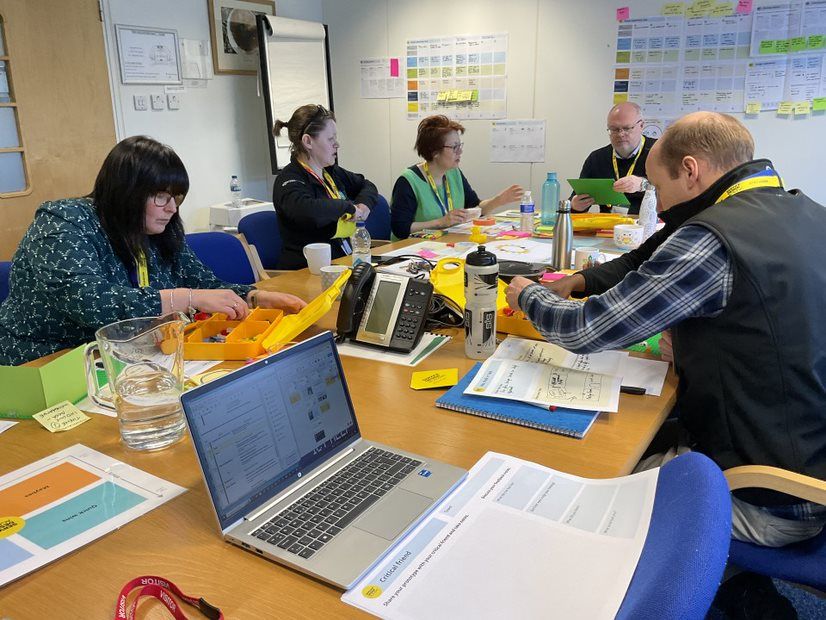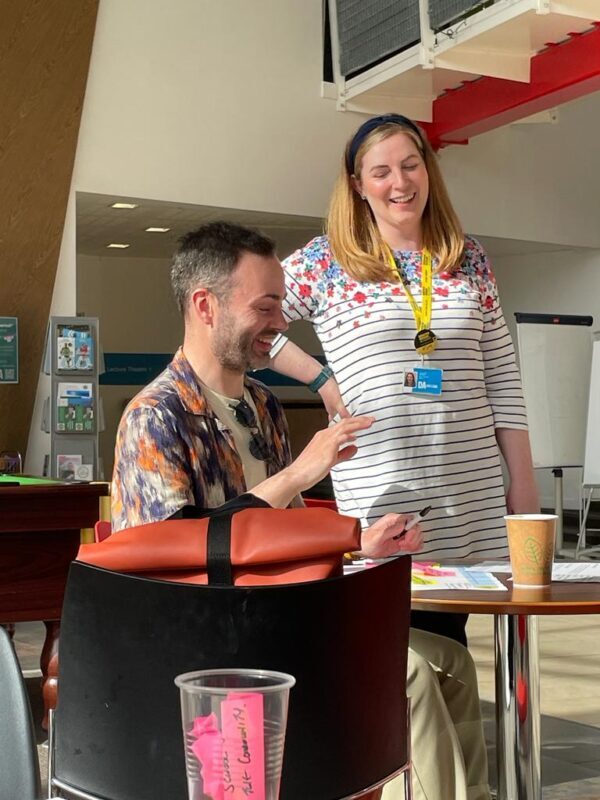Arbroath Academy and the Service Design Academy partnered up in 2019 after receiving a successful bid from Education Scotland’s Creative Curriculum Fund.
Arbroath Academy was aware that their curriculum may no longer be fit for purpose. Attendance data collected showed a disengagement with students, particularly, in 3rd and 4th year upwards. The current curriculum is focussed on those young people who will achieve and secure a higher education place. Only 20% of the current young people attending Arbroath Academy will move onto university with limited opportunities for the remaining 80% of learners.
Arbroath Academy saw an opportunity to design their curriculum with young people and staff at the heart, adopting user research and co-design process approaches to invent the curriculum of the future.
“We wanted to inject some creativity into the system and tackle existing, stubborn challenges in a new way. We’re calling this creative change”
Creativity Team, Education Scotland
To start the discovery process, SDA ran two workshops with a follow up co-design day inviting stakeholders including Education Scotland, Skills Development Scotland (SDS), Angus Council, Developing the Young Workforce (DYW) and members of the PTA.
Workshop 1 – Discovery with young people
Workshop 2 – Discovery with teaching & support staff
Workshop 3 – Co-Design with staff, young people and external stakeholders
Here, Chris Muir SDA Consultant shares his experience of the co-design workshop.
“Co-design is not a one-off event, it’s a journey. Imagine a world where users decide what works best. Imagine a world that encourages all stakeholders to have a say in designing the curriculum of the future.
The brief that the Service Design was given from Arbroath Academy was radical. Only 20% of these young people continue onto university. So why is the current curriculum solely focussed on this group?
Following on from two previous events, that concentrated solely on diving deep into gathering insights, it was time to do something with all that research. Create the right conditions and something magical can happen. The Service Design Academy’s role in this was clear; facilitate (not lead) young people, teachers and partners to collaborate and co-design the curriculum of the future for Arbroath Academy.

Embracing the full value of Co-Design
The day kicked off with some speedy getting to know each other before mapping out the themes that had been discovered during the first 2 days. The mixture of young people (s2–s6) and teaching staff had all their findings collaborated and digested into 49 specific areas of interest. The groups picked themselves by choosing what they wanted to tackle for the rest of the day.
Group Forming through the power of the marshmallow challenge was served up next. What occurred during the next 7 mins was radical and rule breaking at its best (things we do encourage here at SDA). Construct the tallest freestanding tower you can with the material provided. With a bag of chocolate buttons on offer, competition was fierce. Embrace failure you say…nearly every structure was stuck to the desk, oh well the SDA team devoured the buttons on the way home, winning!
Prototype 1 – Giving the pupils a voice

Marc Stickdorn repeatedly says “ideation is cheap, prototyping is underrated”. The groups re-defined their problem around the theme of their group. (Skills, Pupil Voice, School Essentials (physical design), Qualifications, Building Relationships and School Experiences) before carrying out some ideation into the problems they were trying to solve.
After an introduction to prototyping and a reminder that the greatest inventor of all time is called ‘Accident’, the groups jumped straight into designing their solutions. The learn by doing approach was infectious and allowed creativity to flow, if you could capture the energy in the room at this stage of the day it would be worth a small fortune. Co-design is a team sport and those rough first drafts to be fair, were pretty impressive. Now was the time to test and validate those version 1 prototypes.
With the ring of the lunchtime bell a few hundred stakeholders became instantly available to give feedback on the solutions we’d produced. 5 of the groups hit the recreational areas in and around the school and one group stayed in the room and brought stakeholders to see their prototype.

Testing and validating those ideas
Our invited guests, from meaningful learning networks, donned their ‘critical friends’ caps and each joined a group to specifically ask the, ‘yeah, so what?’ and ‘why?’ questions. Importantly we’d called upon the people who could actually make this happen! Ian Lorimer, The Director of Finance at Angus Council (who holds the purse strings), Education Scotland (project funders), SDS, DYW, Lynsey Clark from Calderglen High School/SDA student and members of the Parent Teachers Association all took part as we carried out 3 rounds of pitching and feedback.
Combining the feedback from the school community and the critical friends, each group was asked to create version 2 and re-work their original solution.
Young People & Teachers co-creating their solutions to the skills of the future theme
On completion of version 2 we asked them to tell the story through a visualisation tool called tomorrow’s news, specifically asking them to date it, as we want to see how long it will take for their proposed solution to come to fruition.
One of the completed Tomorrow’s News
The results of the co-design day were inspiring.
- Having an entire week out of the year for teachers and young people to come together specifically to focus on relationship building through clubs, activities and visits outside of the traditional classroom setting.
- Complete classroom design overhaul. Introducing a cosy corner that young people could utilise at times of anxiety and uncertainty.
- A new 13-week block timetable, one that has all theory in the morning and all practical in the afternoon. This would include leaving the school and getting out and about to put into practice the theory you had covered in the mornings. It would involve a whole day being dedicated to the one subject.
- An app for giving young people a louder voice in the school. A ‘we said, you did’ approach to all things in and around the school. This group used the Marvel app to produce a 1st prototype.
- Ways and means of accessing the school curriculum outside of school. Inspired by the Amazon approach of getting exactly what you want online, young people who may miss classes for a variety of reasons (carer, mental health, illness) can pop online and access all the materials they missed that day.
- Re-organising and reviewing the current social and life skills young people want/require for leaving school. Replicating a flat, arranging to pay bills, getting a mortgage, changing a tyre, prepping for interviews in the real world. This would involve the complete re-design of some spaces inside the school for this to be brought to life.
All prototypes and materials were left on display for the rest of the school to review and reflect on. The excitement of everyone involved was tangible. They agreed that something very special had been created by SDA, Arbroath Academy and Education Scotland through the 3 workshops.
What happened next – September 2020 update

This feeling of creating something special has not been lost. Acting, ensuring that all this work has “legs”, embedding the powerful student voice and co-creation skills and the drive and momentum are now a priority
- In May an implementation workshop put ideation into action with members of the senior management team taking responsibility for each theme.
- Two members of staff were so inspired by the service design experience they successfully applied for funding to formalise their learning with the Professional Development Award in Service Design. Before and during the pandemic they’ve run small service design projects as part of their assessments, bringing service design learning into day to day practice.
- Arbroath Academy’s young people and staff have embraced service design and are now engaged once more with the Service Design Academy on an Employability Pathways project.
- Service design is being taught to S2 pupils. It’s been extremely successful so far! They’ve been approached by community champions in the school to use “improving the community in Arbroath” as the overall challenge. So far 5 groups in the year have been:
- • Introduced to the process
- • Discussed the challenge
- • Affinity mapped themes
- • Chosen different themes to work on
- • Created personas and empathy maps for themselves and others
What do they like? A better question would be what’s not to like? The young people simply love the “doing not talking” approach!
It’s about changing the reality of those coming to learn, grow and develop at Arbroath Academy. The education system has a responsibility to be inclusive for one and all. Let’s remember first and foremost, real change only happens when we’re willing to do things we’ve never done before.

Feedback gathered on the day
Scotland’s Curriculum for Excellence states every child and young person is entitled to opportunities for developing skills for learning, skills for life and skills for work.
Arbroath Academy is leading the way, we can’t wait to see what happens next to help our children and young people gain the knowledge, skills and attributes needed for life in the 21st century.”

https://education.gov.scot/Documents/Creative-Curriculum-Fund-Appendix-A-Context.pdf



